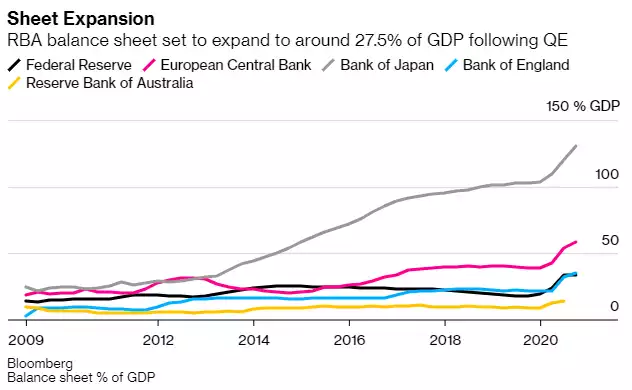Money Printers Go Brrrrrr
News
|
Posted 05/11/2020
|
10973
Whilst the political result of the US election is still unknown, either way the end result will be the same in terms of monetary stimulus and that is MOAR. To date we in Australia have watched with detached fascination the eye watering amounts of money printing happening under the disarming name of Quantitative Easing or QE by the Fed, Bank of Japan, European Central Bank and Bank of England. China’s PBoC has held off to date as their state control mean they can accommodate support through fiscal controls and debt.
Our little central bank that could is now making global headlines with Bloomberg last night running the story “Scale of Aussie QE Program Seen Nearing Fed’s as Buying Begins”:
“The Reserve Bank of Australia’s new quantitative easing program is set to close in on the Federal Reserve’s when measured against the size of the economy, highlighting the scale of its latest stimulus effort.
The plan to buy A$100 billion ($71.2 billion) in bonds over six months will kick off with the expected purchase of A$2 billion of government debt at maturities of 7- to 10-years at Thursday’s auction. Governor Philip Lowe said Tuesday he estimates the RBA’s balance sheet will have almost tripled once purchases are completed by mid-2021, compared with the position at the start of this year.”

The report then talks to Westpac Chief Economist Bill Evans report yesterday where he sees the RBA going much harder and longer than their initial $100b over 6 months foray having “certainly left open” the option of further QE. Evans is predicting the RBA will print around $550b which will take us to 27.5% of GDP, up very close to the Fed’s 34%.
Earlier in the week the AFR ran the headline “RBA brings pea-shooter to bazooka fight” putting the $100b in pure quantum (not as a ratio of GDP) context:
“The simple arithmetic of adding $100 billion of quantitative easing – and assuming no other measures – gets the prospective balance sheet expansion to more than 20 per cent of GDP.
Compare that to the big three central banks – Federal Reserve, European Central Bank and Bank of Japan – which collectively have expanded their balance sheets to about $US22 trillion from more than $US14 trillion at the end of February.
The Fed has expanded its balance sheet by $US3 trillion to $US7 trillion since the end of February and it now stands at 34 per cent of US GDP.
The ECB's balance sheet is about 60 per cent of GDP, while the Bank of Japan – which started down the slippery slope of QE two decades ago – has pushed its balance to about 130 per cent of GDP.
These large-scale asset purchases have helped nail down yields. US 10-year yields are about 0.85 per cent, while Germany's and France's are negative. Japan's 10-year bonds yield three basis points.
Given Australian yields have offered a premium, it's little wonder the Australian dollar has performed strongly against other major currencies.”
The article went on to conclude:
“While the RBA's announcement is history-making, the reality is the outcome of the US election and its impact on the US dollar will probably have more sway on the relative value of the Aussie dollar in the short term than the RBA's QE plans.”
And that’s exactly what happened. On the very day of the announcement, the USD fell amid the election uncertainty and the AUD surged as the numerator. Not exactly to the RBA’s plan…
The reality is that the RBA will need to extend and extend to remain competitive in the global race to the bottom.
The ECB recently indicated they are likely to unleash more QE at their next meeting and tonight the Bank of England is widely expected to ramp up its QE program as they enter a double dip recession.
Now at just 0.1% the RBA have nowhere to go but zero or negative from here on interest rates. QE is all they have left by choice. Phillip Lowe is on record as not wanting to go into negative interest rates but also acknowledged they may have to. He is watching and referencing as evidence the damage negative rates are unleashing on European banks and is reluctant to do that to ours.
And so it seems likely that the money printers at the RBA, as with all major central banks around the world, will continue to go brrrrr and continue to debase that stuff in your wallet and bank we still try to call money. Real money must have intrinsic value by virtue of limited supply. Gold, silver, platinum, and bitcoin all tick that box. Currency does not. Period.